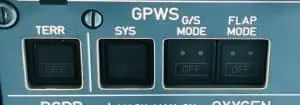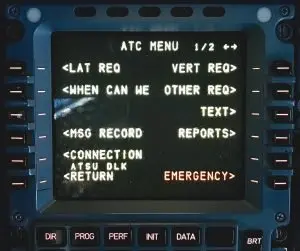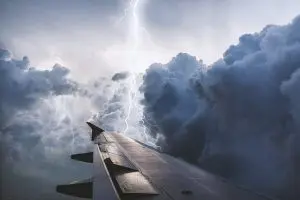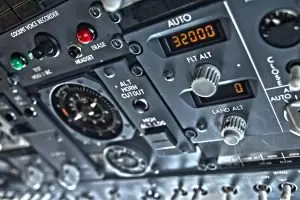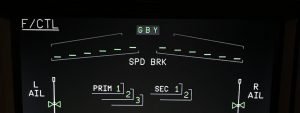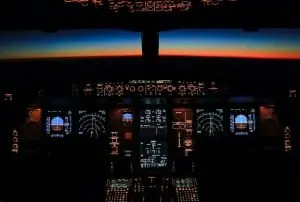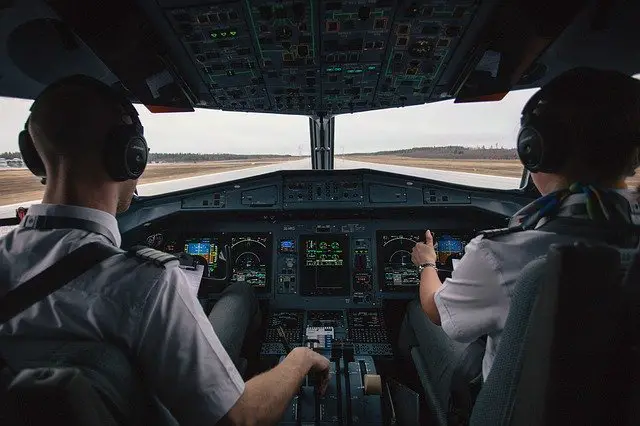
Pete has been flying aircraft for the last 20 years. He has flown everything from light piston aircraft up to heavy jets as both First Officer and Captain. He’s currently enjoying life flying the Airbus A330 for a major international airline.
A Ram Air Turbine (RAT) is an emergency system that can be deployed by an aircraft that uses the force of the airstream to turn a small propellor which produces either electrical or hydraulic power.
Table of Contents
What happens when the RAT deploys?
The Ram Air Turbine, or RAT, is designed as an emergency backup to supply flight controls with hydraulic power and electricity via an emergency electrical generator (EMER GEN).
With the loss of both engines the RAT will deploy due to the loss of electrical supply to both main bussbars. In this situation the Ram Air Turbine will supply hydraulic power which is used to power the emergency electrical generator (EMER GEN).
The EMER GEN supplies limited electrical power to primary instruments and critical systems. Most of the screens will be lost. The captains PFD (Primary Flight Display) is the only one remaining and they will take control. The ECAM is limited to being displayed on the E/WD (Engine/Warning Display). The QRH (Quick Reference Handbook) is available to the crew in the flight deck and will provide a summary of the systems available.
With the EMER GEN supplied by the RAT the systems will be limited to PFD1 (Primary Flight Display), the number 1 navigations systems (VOR1, ILS1, GPS1) and radio communication on VHF1 only.
During the final stages of the approach the EMER GEN will disconnect (electrical power will be supplied by the batteries) to free up the RAT to solely supply hydraulic power.
Once the RAT is deployed it cannot be retracted in the air.
Learn about how ECAM/EICAS display information about aircraft systems.
How pilots use the QRH (Quick Reference Handbook) in an emergency.
Airbus Emergency Electrical (EMER ELEC) Configuration
On the Airbus A320 and A330 EMER ELEC Configuration refers to the situation when the aircraft loses AC BUS 1 and 2 (these are normally supplied by electrical generators on engine number 1 and 2 respectively).
In the event of a loss of both AC BUS 1 and 2 the RAT will deploy automatically to supply hydraulic power to the emergency generator (EMER GEN). The emergency generator will supply electrical power to essential systems via the AC and DC ESS BUS.
The Airbus FCTM (Flight Crew Techniques Manual) states:
This is a serious emergency and ATC should be notified using appropriate phraseology (“MAYDAY”).
Although the ECAM displays LAND ASAP in red, it would be unwise to attempt an approach at a poorly equipped airfield in marginal weather. However, prolonged flight in this configuration is not recommended.
Crews should be aware that workload is immediately greatly increased.
In Emergency Electrical configuration the available systems are much reduced. The Autopilot and Flight Director (AP/FD) are lost, together with the auto thrust (ATHR), so the crew will have to manually fly the aircraft.
The majority of the screens are lost. As this is considered a “complex procedure” due to the amount of lost systems, the Quick Reference Handbook (QRH) will have a summary of the remaining available systems.
The crew will prioritise securing the aircraft and establishing a safe flight path first. Aviate – Navigate – Communicate.
Aviate – the aircraft will be flown with reference to PFD1. The pilot in the left seat becomes pilot flying. All the first officer’s screens are lost together with the Systems Display screen of the ECAM.
Navigate – ILS1, VOR1 and GPS1 are available and allow a landing to be completed in CAT 1 weather conditions.
Communicate – Only VHF1 is available and will be used to declare a MAYDAY.
How pilots deal with emergency situations.
Airbus A330 Ram Air Turbine (RAT)
The RAT on the A330 supplies hydraulic pressure to the green hydraulic system. In the case of a dual engine failure the RAT will supply flight controls and the emergency generator.
The RAT may be extended either manually at any time by pressing the “RAT MAN ON” pushbutton. Alternatively, the RAT will deploy automatically in the case of dual engine failure or in the event of hydraulic low level in either a.) green and yellow, or b.) green and blue systems.
Normal hydraulic pressure on the A330 is 3000psi, but the RAT will only supply 2500psi. When the RAT supplies green hydraulic pressure the aileron, elevator and spoilers servo control operating speeds are reduced.
Related: The Airbus A330 Hydraulic System
Airbus A320 Ram Air Turbine (RAT)
The Airbus A320 Ram Air Turbine (RAT) is used in the event of a dual engine failure or serious electrical problem to supply electrical power.
As with the A330, it can be deployed manually. It deploys automatically with the loss of both engines and an airspeed greater than 100 knots.
On the A320 the RAT supplies electrical power to the essential busses (ESS AC and ESS DC) which provide essential equipment needed to land the aircraft.
As the aircraft slows below 125kt the RAT will stay and will no longer supply the emergency generator. For this reason the approach is flown at minimum approach speed of 140kts until landing is assured.
When this is the case and the aircraft slows, emergency electrical power from from the batteries and 2 busbars that are no longer required and are shed to save power (AC SHED ESS and DC SHED ESS buses). As the aircraft slows down during landing other busbars are shed.
For more on the Airbus A320 RAT take a look at:
The A320 Ram Air Turbine (RAT) – A Pilot’s Guide
A Guide to the Airbus A320 Hydraulic System
An real-world example of the RAT in use: The Azores Glider
An example of the use of the Ram Air Turbine was on Air Transat TS236 on August 24th 2001. This flight was on an Airbus A330 from Toronto to Lisbon. Four hours into the flight over the Atlantic Ocean a fuel line supplying engine number 2 ruptured resulting in a fuel leak.
Unbeknownst to the crew a fuel line supplying engine number 2 ruptured. After some time the crew received a warning of fuel imbalance between the wings and, still unaware of the leak, carried out a QRH procedure to balance the fuel.
This subsequently lead to all the fuel being lost and the flameout of both engines. The RAT deployed and supplied hydraulic power which in turn drove the emergency generator (EMER GEN). This deployment of the RAT allowed limited control of the aircraft.
Despite the loss of both engines, and with very limited instrumentation, the crew managed to glide the A330 to a successful landing at Lajes airport in the Azores.
While there was some criticism of the initial actions of the crew, and following this event crew procedures were updated, what they achieved was amazing. To glide a passenger aircraft to a safe landing in the middle of the Atlantic is nothing short of amazing, and it shows the crucial role the RAT played.
For more information here is a link to the accident report together with a video about the event.
Further Reading: Ram Air Turbine
RAT on the Concorde – heritageconcorde.com
A Guide to the Ram Air Turbine (RAT) – Airbus A320
A Guide to the Ram Air Turbine (RAT) – Airbus A380
Thanks to Bill at Cat3C.com for getting in touch with the following 737 insight: “The 737 can also be flown with a complete loss of hydraulics as the flying controls have manual reversion. Stick forces are very high but the aircraft is controllable.”
If you have any questions about Ram Air Turbines please feel free to email me!
If you found this article interesting please take 5 seconds to share this on your favorite social media. Thanks so much, I really appreciate it! [email protected]
FAQ Summary – Ram Air Turbines (RATs) on Aircraft
Does the Boeing 737 have a Ram Air Turbine?
No the Boeing 737 does not have a Ram Air Turbine (RAT) as it doesn’t need one. In the event of a dual engine failure the windmilling engines can deliver hydraulic pressure by their associated Engine Driven Pumps (EDP), and the EDPs are further backed up by Electrical Motor Driven Pumps (EMDP). In the event of a dual engine failure the EMDP would receive an electrical supply from either the APU or batteries.
The 737 can also be flown with a complete loss of hydraulics as the flying controls have manual reversion. Stick forces are very high but the aircraft is controllable.
Does the 787 have a RAT?
The Boeing 787 has a RAT which, in the event of dual engine failure, will supply electrical power which will provide partial hydraulic power.
Does the Boeing 747 have a Ram Air Turbine?
Some models of the 747 have a RAT. The newer 747-8 has a RAT which would supply hydraulic pressure in the event of some hydraulic emergencies. The 747-400 and earlier models do not have a RAT.
What is the Emergency Generator (EMER GEN) on Airbus aircraft?
The Emergency Generator is a backup system that can use hydraulic power from the Ram Air Turbine (RAT) to supply electrical power to the aircraft.
What is Emergency Electrical/EMER ELEC Configuration on Airbus aircraft?
Emergency Electrical Configuration on Airbus aircraft refers to the situation following the loss of electrical power to AC BUS 1 and 2. Backup power is supplied by the Ram Air Turbine which in turn supplies the Emergency Generator (EMER GEN) that supplies limited electrical power. In this situation the available aircraft systems are greatly reduced.
What does it mean to say the Boeing 777 has a hybrid RAT?
On the Boeing 777 the Ram Air Turbine is considereded because the turbine is connected to en electrical generator and a hydraulic pump. This means the RAT on the 777 can supply both electrical and hydraulic power to the aircraft.
What is an electrical busbar?
An electrical busbar allows associated equipment to be grouped together. For example, on the A320 the DC BAT BUS deals with components connected to the batteries.
Featured image: Wikimedia

Pete has been flying aircraft for the last 20 years. He has flown everything from light piston aircraft up to heavy jets as both First Officer and Captain. He’s currently enjoying life flying the Airbus A330 for a major international airline.

